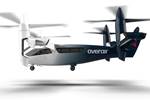Overair Butterfly eVTOL to incorporate Toray carbon fiber, resin system
The Butterfly is expected to take flight in densely populated cities in 2023, complete with Toray’s T1100/3960 prepreg system used in the airframe structure and propulsion units.
Overair Inc. (Santa Ana, Calif., U.S.) and Toray Composite Materials America Inc. (Tacoma, Wash., U.S.) have announced a strategic collaboration on the use of Toray’s advanced prepreg system in Overair’s Butterfly prototype program. Said to be unparalleled in safety and efficiency, the Butterfly is a low-noise, zero-emission electric vertical takeoff and landing (eVTOL) aircraft that will provide sustainable aerial ridesharing in densely populated cities.
The Butterfly prototype aircraft incorporates Toray’s T1100/3960 prepreg system, a material that is formulated for high-performance aerospace applications where the optimal ratio of strength to modulus properties is critical. Toray’s 3960 is a highly toughened 350°F/177°C cure epoxy resin with a glass transition temperature (Tg) of 400°F/204°C. It is optimized for increased performance and enables for autoclave and out-of-autoclave (OOA) curing, according to the company. The resin is synergistic with the Torayca T1100 intermediate modulus plus (IM+) carbon fiber, which Toray claims is the highest tensile strength fiber available today. The T1100/3960 unidirectional (UD) and plain weave prepreg is used in the Butterfly’s airframe structure and propulsion units.
“We’re excited to be working closely with Toray’s advanced materials as we continue the development of our all-electric Butterfly experimental prototype aircraft,” Ben Tigner, co-founder and CEO at Overair, says. “Our unique propulsion system requires materials that provide a unique combination of high stiffness and high strength, while also maintaining the optimal weight targets for the vehicle.”
Overair recently completed full-scale testing of Butterfly’s propulsion system. The successful testing program validated Overair’s design choices and Butterfly’s expected performance capabilities. Butterfly’s propeller will be showcased at the Farnborough International Air Show from July 18-22 in Farnborough, England.
“It is an honor for Toray to partner with Overair on this endeavor and provide the Butterfly a unique performance advantage with our 3960 prepreg system,” according to Jeff Cross, director of business development for Aerospace at Toray. “We’re excited for the future as Overair proceeds with full-scale development and testing. The proven performance of our materials gives me confidence that we can help achieve Overair’s objective of producing the safest, most efficient, and reliable eVTOL aircraft.”
Related Content
-
Materials & Processes: Fabrication methods
There are numerous methods for fabricating composite components. Selection of a method for a particular part, therefore, will depend on the materials, the part design and end-use or application. Here's a guide to selection.
-
Plant tour: Spirit AeroSystems, Belfast, Northern Ireland, U.K.
Purpose-built facility employs resin transfer infusion (RTI) and assembly technology to manufacture today’s composite A220 wings, and prepares for future new programs and production ramp-ups.
-
Materials & Processes: Fibers for composites
The structural properties of composite materials are derived primarily from the fiber reinforcement. Fiber types, their manufacture, their uses and the end-market applications in which they find most use are described.

















